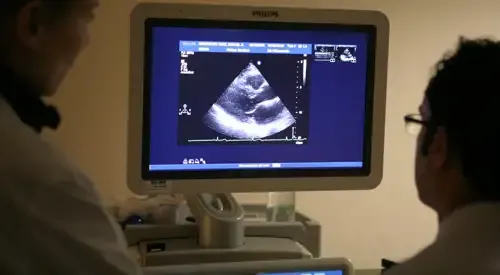Aortic insufficiency
"If the disease progresses and the insufficiency is not corrected, the condition of the heart chambers becomes irreversible, producing congestive heart failure".
DR. MIGUEL ARTAIZ URDAZI
SPECIALIST. CARDIOLOGY DEPARTMENT

Aortic insufficiency is caused by defective closure of the aortic valve that results in a leakage (regurgitation) of blood from the aorta into the left ventricle with each heartbeat.
This leakage of blood, generates an overload of volume in the left ventricle that with time can dilate.
If the disease progresses and the insufficiency is not corrected, the condition of the heart chambers becomes irreversible producing congestive heart failure.
Our specialists are trained in international centers and have extensive experience in performing cardiac surgical techniques.

What are the symptoms of aortic insufficiency?
The symptoms are due to the volume overload that produces the return of a part of the blood expelled by the left ventricle to the same.
Aortic insufficiency, when chronic, can develop for years without symptoms.
When they appear they can do so gradually or they can settle quickly.
In acute aortic insufficiency (endocarditis or aortic dissection), these symptoms develop suddenly and are poorly tolerated by the patient.
The most common symptoms are:
- Shortness of breath (dyspnea).
- Chest pain that worsens with exercise and subsides with rest.
- Swelling of the ankles (edema).
- Fatigue.
Do you have any of these symptoms?
You may have aortic insufficiency
What are the causes of aortic insufficiency?
The causes of aortic insufficiency classically include
- Bicuspid aortic valve
- Dilatations of the valve ring in conjunction with an expansion of the aorta, which prevent an effective closure of the aortic valve.
- Rheumatic fever.
- Infectious Endocarditis.
- Aortic dissection.
- Marfan syndrome.
- Ankylosing spondylitis.
- Congenital valve problems.
- Autoimmune diseases (systemic lupus erythematosus).
- Reiter's syndrome.
- Arterial hypertension.
- In certain cases aortic stenosis may be accompanied by heart failure.
In an acute way, we can find:
- Bacterial Endocarditis.
- Acute aortic dissection.
What is the prognosis of aortic insufficiency?
The ventricle, over time, enlarges and fluid builds up.
If this situation lasts too long, symptoms of heart failure can occur.
How is aortic insufficiency diagnosed?

Electrocardiogram: alterations in the rhythm can be observed as well as it gives us information about thickening of the left ventricle suggestive of aortic stenosis.
Chest X-ray: In this study the size of the heart is normal. An increase in the size of the aorta can be observed. In some cases the aortic calcifications can be observed.
Echocardiography: A thickened and calcified aortic valve that opens little can be visualized, as well as the functioning of the left ventricle. With the addition of doppler, flows through the valve can be measured to assess the degree of stenosis.
How is aortic insufficiency treated?
Valve surgery is open heart surgery, that is, the heart's chambers or vessels are opened to access the valves. It is performed under general anesthesia, through an incision in the sternum.
During the operation, a heart-lung machine is used to perform heart and lung functions, oxygenate the blood, and allow surgeons to stop the heart and work within it.
The duration of the surgery is usually between 3 and 4 hours, although it can be longer depending on the valves to be repaired or replaced.
Where do we treat it?
IN NAVARRE AND MADRID
The Department of Cardiology
of the Clínica Universidad de Navarra
The Department of Cardiology of the Clinica Universidad de Navarra is a center of reference in different diagnostic techniques and coronary treatments.
We have been the first center in Europe to place a pacemaker by means of a catheterization without the need to open the chest, for cases of severe heart failure.
The Cardiology Department of the Clinic collaborates with the Radiology and Cardiac Surgery Departments to achieve a quick and precise diagnosis of the patient.

Why at the Clinica?
- Specialized Arrhythmia Unit of national reference.
- Unit of Hemodynamics and Interventionist Cardiology equipped with the best technology.
- Cardiac Imaging Unit to achieve the highest diagnostic accuracy.


















